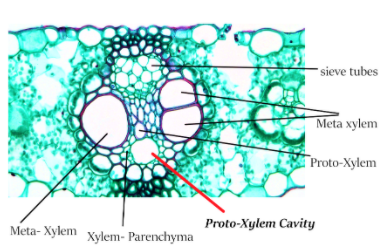Answer
393.9k+ views
Hint: It is monocot plant, cambium is not present in the vascular bundles i.e the vascular bundles are closed, collateral or lepto centric and conjoint.
Complete answer:
The only monocot in the given options is Maize. Pinus and cycas are gymnosperms and thus out of discussion of monocot and dicot. Sunflower is an angiosperm but it is a dicot. In vascular bundles of maize, xylem parenchyma cells and the lowermost proto-xylem vessels dissolve to form schizo-lysigenous cavity (water containing cavity) known as proto-xylem cavity or lysigenous cavity or lacuna or Proto-xylem cavity. In the smaller vascular bundles in maize the absence of protophloem may be observed.

Additional information:
Both upper and lower epidermises are uniseriate and well cutinized. Within the upper, or adaxial, epidermis, large white bulliform cells shrink, allowing the leaf to roll during drought. Vascular bundles in monocots are of different sizes, the smaller size bundles are present in peripheral areas and larger ones in the center. They seem to be embedded in ground tissue in a cross section. The bundle sheaths made up of sclerenchyma encircles the vascular bundle. The bundle caps are absent. Usually in monocots hollow stems are present. The arrangement of their vascular bundles appeared to be in a ring, due to the rare space. It increases the flexibility of the stem which results to satisfy the great need of required property for the aquatic plants of running water, while at the same time it decreases the strength of the stem, which may affect terrestrial plants.
Note:The presence of hollow stems can be used as one of the identifying features to distinguish Monocots from Dicots and Gymnosperms.
Complete answer:
The only monocot in the given options is Maize. Pinus and cycas are gymnosperms and thus out of discussion of monocot and dicot. Sunflower is an angiosperm but it is a dicot. In vascular bundles of maize, xylem parenchyma cells and the lowermost proto-xylem vessels dissolve to form schizo-lysigenous cavity (water containing cavity) known as proto-xylem cavity or lysigenous cavity or lacuna or Proto-xylem cavity. In the smaller vascular bundles in maize the absence of protophloem may be observed.

Additional information:
Both upper and lower epidermises are uniseriate and well cutinized. Within the upper, or adaxial, epidermis, large white bulliform cells shrink, allowing the leaf to roll during drought. Vascular bundles in monocots are of different sizes, the smaller size bundles are present in peripheral areas and larger ones in the center. They seem to be embedded in ground tissue in a cross section. The bundle sheaths made up of sclerenchyma encircles the vascular bundle. The bundle caps are absent. Usually in monocots hollow stems are present. The arrangement of their vascular bundles appeared to be in a ring, due to the rare space. It increases the flexibility of the stem which results to satisfy the great need of required property for the aquatic plants of running water, while at the same time it decreases the strength of the stem, which may affect terrestrial plants.
Note:The presence of hollow stems can be used as one of the identifying features to distinguish Monocots from Dicots and Gymnosperms.
Recently Updated Pages
How do you arrange NH4 + BF3 H2O C2H2 in increasing class 11 chemistry CBSE

Is H mCT and q mCT the same thing If so which is more class 11 chemistry CBSE

What are the possible quantum number for the last outermost class 11 chemistry CBSE

Is C2 paramagnetic or diamagnetic class 11 chemistry CBSE

What happens when entropy reaches maximum class 11 chemistry JEE_Main

Calculate the volume occupied by 88 gram of CO2 at class 11 chemistry CBSE

Trending doubts
Assertion CNG is a better fuel than petrol Reason It class 11 chemistry CBSE

How does pressure exerted by solid and a fluid differ class 8 physics CBSE

Number of valence electrons in Chlorine ion are a 16 class 11 chemistry CBSE

What are agricultural practices? Define

What does CNG stand for and why is it considered to class 10 chemistry CBSE

The rate of evaporation depends on a Surface area b class 9 chemistry CBSE

Difference between Prokaryotic cell and Eukaryotic class 11 biology CBSE

State whether the following statement is true or false class 11 physics CBSE

A night bird owl can see very well in the night but class 12 physics CBSE



